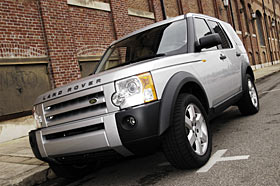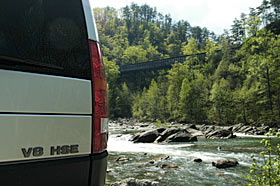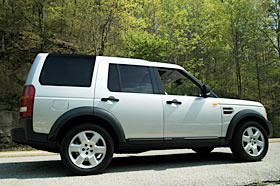|
|
|||||||||
|
Far gone are the days of the simple utilitarian Land Rovers, such as the Series models and the later Defenders that put off-road prowess in front of styling and comfort. Today’s Land Rovers – especially the LR3 and the top-of-the-line Range Rover – combine legendary off-road capabilities with on-road performance, luxurious, pimped-out styling, comfort and safety. We wanted to learn more about today’s Land Rovers, so we arranged to spend a week in an LR3. Not only that, but we booked a trip to the new-in-2004 Land Rover Experience Driving School, held at the historic Biltmore Estate near Asheville, North Carolina. What better way to get acquainted with the latest that Land Rover has to offer, right? Oh, the things we suffer through for our readers. Our LR3 was a Zambezi Silver HSE model, trimmed out in Alpaca Leather and had a sticker price just north of $53,000. Powered by a 4.4L 300hp (@5500rpm), 315lb.-ft (@4000rpm) Aluminum Alloy V8 engine, sourced from Jaguar, the LR3 was equipped with all the goodies, including a 550W sound system, GPS navigation, third row seats, rear climate controls and cold climate package. The HSE also includes a step up from 18” wheels to 19’s, mounted on 255/55HR19 tires. Speaking of tires, the LR3 moves the spare tire away from the tailgate to underneath the rear cargo area. Though not the safest place for a spare tire off-road, it does mean a lighter tailgate, which is nice for daily use. Our trip would take us about 350 miles from Birmingham, Alabama to the Biltmore. Call me spoiled, but I don’t like station surfing, so I decided to take along my XM radio receiver, which sat nicely on the LR3’s dash. Sources tell me that in 2006 Land Rover will finally realize that Americans like their satellite radio and will begin offering it as an option in the LR3 and Range Rover. The XM worked wonderfully, transmitting its signal to an FM station in the LR3, so we were able to take advantage of the great stereo system onboard.
Though we didn’t have to for luggage reasons, we did fold down the rear seats of the Rover to check out the load space. It was huge! With the 35/30/35 split middle row down and the fold-flat third row down, you get a flat cargo floor from front to back. The rear gate splits so if you put the glass up and the tailgate down you could carry some serious loads home from Lowe’s for a weekend full of home improvement. The split middle and third rows mean that you could still carry long cargo with 2 or even 3 passengers onboard. Very nice. We decided that our trip should be just as much a getaway as a vehicle test, so we took the scenic route to Asheville and avoided the interstates as much as possible. Getting out of town, however, proved a little confusing for the navigation system, as regardless of which setting we used, it just couldn’t figure out how to get us en route the right way. This would occur throughout the trip, as we had a route from our atlas we wanted to take that made sense and was direct. The nav. just couldn’t seem to understand our plan and continually wanted us to turn around or take routes that we did not want to take. This is not to say that the nav was no good. Perhaps many years of traveling and planning routes meant that I was a little too smart for the computer. Had I not had an Atlas and did not have prior knowledge to where I was going – or if I had chosen to take the “easiest” and most sensible routes (meaning interstates), the nav would have done great and gotten us there just fine. Regardless of our fumblings with the system, we did use it the whole way and it was a nice tool to have onboard. Just don’t leave your atlas at home if you’re taking long trips and want to see the real America – the one off the Interstates.
With a curb weight of 5,400-5,800 pounds, the LR3 needs motivation to get going. But unlike other vehicles in its class, such as the HUMMER H2, the LR3 has the proper powertrain to do it. The engine has plenty of power and torque to move it along. Power is routed through a six-speed automatic with CommandShift manual control. Acceleration is smooth throughout the powerband and the automatic is one of the smoothest we’ve driven to date. Stepping on the gas hard from a stop or low speeds, however, can result in a delay – not unlike a turbo spooling up. It was similar in feel to that of the Volvo XC90 which was curious, since the LR3 does not have a turbo. On several occasions, the delay almost meant trouble for us on the road. Switching to manual shifting, though, made the delay go away. Manual mode allowed for faster take-offs and better acceleration when passing on two lane roads. It was also a lot more fun to drive. Winding through Cherokee National Forest in Tennessee, we really got to test out the LR3’s mettle. The road winds through the mountains along the white rapids of the Ocoee River. This route is one of the most beautiful I’ve driven this side of the Rockies. Though it would have been a lot more fun to drive this road in my Miata, the LR3 proved to be quite fun in its own right.
Land Rover claims a 0-60 time of 8.0 seconds, which is about 2-3 seconds faster than my best time in my 2000 pound Miata! Keeping the LR3 in 2 nd gear, the LR3 took the turns and stuck to the pavement nicely, thanks to independent front and rear suspensions and the alphabet soup of braking systems used for stability and traction control.
Brakes on the LR3, as we mentioned earlier, are some of the most advanced on any vehicle built today. Not only do they handle stopping duty with four-channel ABS, but they also have Electronic Brake Distribution (EBD), Emergency Brake Assist (EBA), Cornering Brake Assist (CBC), Active Roll Migration (ARM), all-terrain Dynamic Stability Control (DSC), and Hill Decent Control (HDC). Wow! That’s a lot of stuff! The upside, of course, is better handling in all conditions. These systems work in harmony to keep the LR3 going along its intended path, be it on dry pavement, snow, mud or off-road. How would you like to go through that computer code! The brake systems got a full-on workout throughout our trip, both on the road and at the driving school. When on-road the systems work invisibly and you don’t even know they are there. If all this braking stuff isn’t enough to keep you out of trouble, or trouble finds you instead, there are eight airbags throughout the three-row LR3’s to protect passengers. The LR3’s body and frame construction provided a stable and tight ride. The vehicle felt well-screwed together and was creak-free during our nearly 800 miles of use. Fit and finish was excellent for the most part, with the exception of a tailgate that was a bit hard to close fully on several occasions and even got in a half-way position of won’t open and won’t shut during a rain storm. The ride to Asheville was a real pleasure. The interior of the LR3 is very well-appointed, with all the technical doodads and ergonomic features you’d expect. The seats, though a bit too firm for my liking, were fully adjustable and the steering wheel not only tilted but also telescoped, which was very nice for an all-day drive, since we could find a comfortable long-term position to be in. One thing we also liked was the adjustable armrests, which could be angled up or down (manually) for taller or shorter drivers using a knob on the front of each rest. This is a similar mechanism as the one found in the HUMMER H1.
As we approached Asheville, we began using the navigation system again. It instructed us turn-by-turn (correctly) on how to get to the Biltmore Estate. Upon our arrival, we were welcomed at the guard house and given out estate pass and directions to the Inn on Biltmore Estate.
|
|||||||||

 This year, Land Rover introduced the LR3, which replaces the outgoing Discovery here in the US. In a move to not only reinvent the mid-range Land Rover, but to also separate it from its now-retired stable mate, Land Rover decided to give the model a new name here in the States. There really is so much new and different in the LR3 that the new name is deserved.
This year, Land Rover introduced the LR3, which replaces the outgoing Discovery here in the US. In a move to not only reinvent the mid-range Land Rover, but to also separate it from its now-retired stable mate, Land Rover decided to give the model a new name here in the States. There really is so much new and different in the LR3 that the new name is deserved.





 The Discovery had a stepped roof and that has been carried over to the LR3. Providing more headroom, the roof also features a wide-open view of the skies for all seven passengers. The sunroof up front and the middle row glass (which does not open) both feature a hidden sun screen, which can be used to cut down on rays from above on sunny days. We found the screen to be wonderful along this section of road since we wanted to hear the white water rushing as we drove by – XM off, of course. With the windows and the sunroof open, the screen kept the sun from beating on my head, while still allowing an open-air feeling. Nice.
The Discovery had a stepped roof and that has been carried over to the LR3. Providing more headroom, the roof also features a wide-open view of the skies for all seven passengers. The sunroof up front and the middle row glass (which does not open) both feature a hidden sun screen, which can be used to cut down on rays from above on sunny days. We found the screen to be wonderful along this section of road since we wanted to hear the white water rushing as we drove by – XM off, of course. With the windows and the sunroof open, the screen kept the sun from beating on my head, while still allowing an open-air feeling. Nice.
